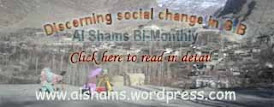 July 11: Shia Imami Ismaili community of Muslims Ummah celebrated 'Yaum-e-Imamat', the day of succession of Shah Karim al-Hussaini,known as Aga Khan (4th) as 49th Imam (leader) on Sundary 11 July, 2010. The day marked with and started with special prayers for integrity, global peace, inter communal faith harmony, prosperity of the country and for the resolution of challenges by humanity in to days world. Speakers in public gatherings highlighted contribution of Aga Khan (iv) for human well being across the world through a comprehensive net work named Aga Khan Development Network (AKDN), working for the improvement of health care facilities, socio-economic, cultural, intellectual development and inter-communal faith harmony across the globe.
July 11: Shia Imami Ismaili community of Muslims Ummah celebrated 'Yaum-e-Imamat', the day of succession of Shah Karim al-Hussaini,known as Aga Khan (4th) as 49th Imam (leader) on Sundary 11 July, 2010. The day marked with and started with special prayers for integrity, global peace, inter communal faith harmony, prosperity of the country and for the resolution of challenges by humanity in to days world. Speakers in public gatherings highlighted contribution of Aga Khan (iv) for human well being across the world through a comprehensive net work named Aga Khan Development Network (AKDN), working for the improvement of health care facilities, socio-economic, cultural, intellectual development and inter-communal faith harmony across the globe. Shah Karim Al-Hussaini succeed his grand father Sir Sultan Muhammad Shah (Aga Khan iii)
 around 53 years back in 1957 as an Imam of the community in a young age. Like his grand father, he proved himself a leader of global rapport and delivered numerous accomplishments not only for his own community, Muslim umma but also for rest of the world without any discrimination of caste, creed, faith,and culture. It was his dynamic leadership of Him and his grand father that with in a short span of time, his community emerged as a stable, well organized and knowledge based entity across the world. According to the senior citizens of the the region, it was first ever visit of Aga Khan (4th)in 1960s, this area started to stand on its foot as he started new initiatives to improve standard of living of the people under the banner of Aga Khan foundation.
around 53 years back in 1957 as an Imam of the community in a young age. Like his grand father, he proved himself a leader of global rapport and delivered numerous accomplishments not only for his own community, Muslim umma but also for rest of the world without any discrimination of caste, creed, faith,and culture. It was his dynamic leadership of Him and his grand father that with in a short span of time, his community emerged as a stable, well organized and knowledge based entity across the world. According to the senior citizens of the the region, it was first ever visit of Aga Khan (4th)in 1960s, this area started to stand on its foot as he started new initiatives to improve standard of living of the people under the banner of Aga Khan foundation.His unprecedented efforts in Islamic world for preservation of civilization as a mean of Identity as a nation and constant emphasis to respect pluralism, diversity, tolerance, acceptance, integrity, co-existence, equal opportunity, hard work, humanitarian work and after all to hold ourselves responsible of our acts before a supreme power are the some of the key factors to solve the challenges faced by the contemporary world in term of revolts, extremism and violence.
 Shah Karim Al-Hussaini, Aga Khan, 49th contemporary spiritual leader of the Shia Imami Ismaili Muslim community enjoys global regard for his philanthropic work for humanity.
Shah Karim Al-Hussaini, Aga Khan, 49th contemporary spiritual leader of the Shia Imami Ismaili Muslim community enjoys global regard for his philanthropic work for humanity. Image source:Simerg.com
On the occasion of Imamat day, we the team of VoH would like to extend our heartiest wishes to the followers of Shia Imami Ismaili community and pray for a violence free just global society where terms namely uneven distribution of wealth, oppression, tyranny, intolerance, apathy and arrogance hardly found there in.
 HUNZA, Hyderabad: A community centre elumintated with lighening bulbs give a chamful feelings on 53rd Imamat day of Aga Khan as 49th Imam
HUNZA, Hyderabad: A community centre elumintated with lighening bulbs give a chamful feelings on 53rd Imamat day of Aga Khan as 49th ImamYet, there exists concerns of even those belong to the community over the conventional methods and projects hardly address the socio-economic and intellectual needs of the the people saying a visible deviation for the reason these institutions under AKDN were established.
Courtesy: Voice of Hunza




